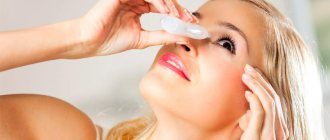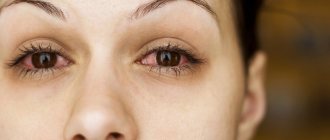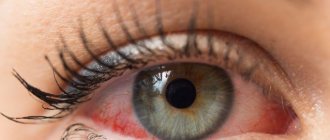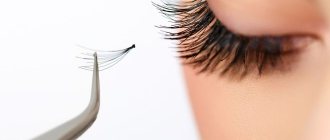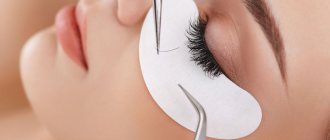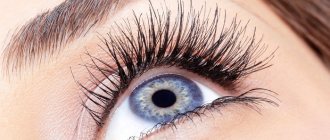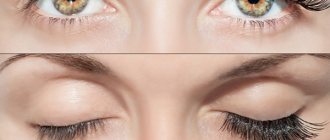Eyelashes are hair that is located on the lower and upper eyelids. They are designed to protect the eyes from small foreign particles. The roots of the eyelashes end in a bulb, which is responsible for hair growth. It is located approximately 2 mm deep in the eyelid. The cilium shaft consists of three layers: the core or shaft, the cortex and the cuticle. The latter serves as a protective shell from external influences.
What is it and why can it hurt?
Eyelashes have the same structure as any hair on the human body:
- bulb or hair follicle;
- sheathed rod:
- hair shaft.
You can often hear complaints about pain at the roots of hairs.
This problem can be caused by several factors, ranging from ordinary fatigue to more complex diseases of the eyelids or eyelashes. If your eyes hurt from overwork, the main symptoms are a feeling of sand under the eyelids, redness of the whites, swelling of the eyelids and tearfulness. With such external manifestations, it is worth leaving the activity that causes such problems for a while and giving your eyes a rest using soothing measures. Compresses made from strongly brewed tea will help.
Other reasons why eyelashes hurt can be caused by diseases or parasitic lesions of the bulbs:
- Demodectic mange or eye mite often affects people with weak immune systems. The location of small arachnid creatures is the hair follicles of the eyelashes and eyebrows. The main symptom of the disease is irritation of the eyelids at the roots of the hair and itching. My eyes and eyebrows itch very much in the morning. Then redness of the skin at the base of the hairs and peeling become noticeable. Ticks threaten the complete loss of vegetation around the eyes as they destroy the roots.
- A stye on the eye is formed due to inflammation of one or more hair follicles. This pathological process in the skin of the eyelid is accompanied by the formation of an abscess, which, depending on the location, is divided into external and internal barley. In medicine, the disease is called hordeolum.
External purulent inflammation of the eyelid is a more common phenomenon than internal hordeolum and is characterized by pain, the sensation of a foreign body in the eye and a local increase in temperature.
Our readers recommend!
- Features of eyelash extensions when wearing lenses
- How long does an eyelash last on an eyelid?
- Is it possible to wet eyelash extensions: care features
The cause of the disease in most cases is staphylococcus.
- Chalazion translated means “hailstone” or “knot”. This disease is marked by the appearance of a tumor on the lower or upper eyelid due to blockage of the sebaceous gland, which swells inside the skin.
- Blepharitis is an inflammatory process of the skin at the edge of the eyelashes, which is characterized as a chronic disease and is accompanied by redness of the eyelids, swelling, itching and flaking. Blepharitis can be caused by a fungus, infection, mites, or bacteria.
Causes of blepharitis
There are a large number of causes that cause inflammation in the eyelid area. Blepharitis can be caused by bacterial and viral infections, various eye diseases, fungal pathogens, and the eyelids can become inflamed due to exposure to mites and allergens. One of the most common causes of the infectious form of the disease is a staphylococcal infection, which penetrates the hair follicles of the eyelashes. A fairly common cause of pathology is demodex mites. They are present on the skin tissues, hair follicles, and sebaceous glands of many people. Under certain conditions, mites become more active and get on the eyelids, causing inflammation.
Much less commonly, the disease occurs due to the influence of herpes, molluscum contagiosum, intestinal bacteria or yeast-like fungi. Non-infectious blepharitis can be caused by dry eye syndrome, as well as any refractive errors (in the absence of visual correction with glasses or contact lenses). Allergic blepharitis can be caused by cosmetics and hygiene products, pollen, and medications. As a rule, people with highly sensitive eyes react to such irritants with inflammation of the eyelids. Sometimes the allergens that cause blepharitis are formed in the body itself. This occurs in diseases that affect the contents of the meibomian glands (tuberculosis, cholecystitis, diabetes mellitus, helminthiasis, gastritis, etc.).
Provoking factors for the occurrence of blepharitis can be reduced immunity, chronic intoxication of the body, lack of vitamins, anemic conditions, large amounts of dust and smoke in the air, long and frequent exposure to the wind and sun. Also, the development of this inflammation is promoted by chronic infectious foci in various organs and systems of the body (paranasal sinuses, tonsils, oral cavity). Therefore, people with chronic tonsillitis, sinusitis or untreated caries are at increased risk of developing blepharitis.
What can lead to purulent inflammation of the glands
Styes on the eye are the consequences of damage to the hair follicle by staphylococcal or streptococcal bacteria.
In 90% of cases, it is this infection that causes inflammation of the glands at the roots of the eyelashes. More often, children with weak immune systems are exposed to such neoplasms on the eyelids. Less commonly, adults succumb to pathological processes in the skin on the eye. Foci of infection in the body that have become chronic, and diseases that reduce immunity, can provoke the frequent appearance of inflamed tumors on the eyelids.
These factors include:
- untreated caries;
- gastrointestinal diseases;
- chronic sinusitis;
- helminthic lesions;
- diabetes;
- HIV infection.
Reasons why eyelashes become light at the roots
Premature graying of hair around the eyes is called poliosis. With this anomalous phenomenon, the hair around the eyes loses its natural color while the rest of the vegetation on the body has not changed color. Polyosis or white roots can be observed in young people whose age is not conducive to gray hair.
In medicine, it is generally accepted that the cause of this phenomenon is a shock, a long stay in depression, or severe stress experienced. Another source of premature whitening of eyelashes may be a surgical intervention with complications or the presence of an ailment such as trigeminal neuralgia.
Eyelashes are colored by the hair root. But due to the stress it has experienced, it ceases to perform this function and the hair around the eyes becomes white. The white hair no longer changes its color and retains its shade for the rest of its life.
Reasons: why eyelids and eyeballs hurt
The eyes are a sensitive organ, so they are handled with extreme care. When applying eyelash extensions, even a professional cosmetologist with high-quality materials cannot guarantee the absence of consequences.
Mild redness of the eyes, itching or burning may occur for several hours. This is a normal reaction of the body. There are a number of reasons why your eyes hurt or itch:
- Long-term exposure to the skin and glue not drying completely.
- Irritation from protective patches, drying fan.
- Overexertion due to having to keep the eyelids tightly closed.
- Harmful substances that evaporate when the fixative is applied to the eyelashes enter the eyes and irritate the mucous membrane. Itching and redness should go away after three days, and if the pain continues, then you need to remove the eyelashes.
- An undetected disease of the eyes (such as styes or conjunctivitis) or the skin around them. In this case, before visiting an eyelash extension specialist, the disease is treated.
- Early wearing of contact lenses. They cannot be used during eyelash extensions, two to three hours after.
- Inexperience or carelessness of the master. Accidentally opening an eye (as a result of glue getting on the mucous membrane, a chemical burn) or causing microdamage - such mistakes are made during extensions. As a result, the injured area hurts. A specialist without experience may glue eyelashes incorrectly, fail to follow hygiene rules or technology, which leads to itching, pain, and redness.
- Allergy to low-quality or unsuitable glue.
In case of prolonged discomfort or other complications (eye pain, purulent discharge, pain, severe burning, sandy sensations, blurred vision, blurred vision), you should immediately consult a doctor. This will prevent serious, health-threatening consequences from occurring.
Contact with glue provokes a decrease in visual acuity, leads to a complete loss of the ability to see, leads to incurable pathologies (conjunctivitis, bacterial blepharitis or uveitis) and irreversible damage to the mucous membrane of the eye.
Traditional recipes for relieving itching
Inflammation of the glands at the roots of the eyelashes can be caused by various reasons. In order to get rid of such a symptom, you need to know the exact diagnosis of eye disease.
At home, calendula tincture will help get rid of itching due to demodicosis. A small amount of liquid should be applied to a cotton pad or napkin and wipe the edges of the eyelids, being careful not to get the drug on the mucous membrane. In parallel with this procedure, you need to apply Demalon ointment to the roots twice a day, which will have a negative effect on the pathogens.
For eyelash lice, which is also accompanied by itching, a decoction of tansy helps well. To do this, you need to brew 1 tablespoon of crushed inflorescences in half a liter of hot water and leave for an hour. Then you need to strain the infusion and wash with warm liquid several times a day.
For blepharitis, chamomile and calendula flowers will help relieve itching. Half a teaspoon of each herb should be brewed like tea in a glass of boiling water. The infusion should be allowed to stand for 10-15 minutes and then strained. This tea is consumed orally, 1/3 cup three times a day. At the same time, you can apply fresh basil leaves to your eyes. The plant needs to be washed, slightly dried with a towel and crushed to release the juice. In this form, it should be applied to the eyelids for a few minutes for 3-5 days.
In conclusion
We told you how to treat eyelashes at home. By accurately identifying the cause, you can quickly get rid of certain problems. The detailed video in this article will tell you a few more secrets on how to cure various ailments that negatively affect the eyelashes.
Do you have any questions? Write them in the comments, we will be happy to help!
Did you like the article? Subscribe to our Yandex.Zen channel
Text \ Photo Victoria BOLSHOVA Posted 12/25/2015
0
share:
To favorites
To print
If you want to thank, add clarification or objection to the author - add a comment!
Currently being discussed:
- Lyubov Burkina
20.08.2018
What hair color should I choose? Please give me some advice. I don't know which one I have...
- I
19.08.2018
I had eyelash extensions for 6 months and took a break. After 3 months I increased it again...
- Vasilisa
18.08.2018
Cool hairstyle
18.08.2018
Hi, can I dye my bleached hair (currently red) bright purple...
16.08.2018
Hello! I am a dark girl with black eyes. I want to dye my hair dark...
15.08.2018
The photo shows young beauties. Can older ladies have their eyebrows done? Age...
Comments »
Rules to help maintain healthy eyelashes
The first and most important rule that will help prevent eyelash diseases is personal hygiene. It is also worth remembering that using someone else’s towel, mascara and other things can result in problems with the health of the eyelids and eyes.
Also, for the beauty and excellent appearance of eyelashes, you need to carry out strengthening procedures with natural oils, for example, castor oil. And soothing compresses made from green tea or sage, cornflower and chamomile flowers will relieve fatigue and moisturize the skin of the eyelids.
The article has been verified by the editors
Treatment of blepharitis in children
Pediatric blepharitis has symptoms and treatment similar to adults. But in therapy it is important to take into account the child’s age and select appropriate medications. Along with drug therapy, children are almost always prescribed nutritional correction, a hypoallergenic diet, and local use of herbal decoctions with anti-inflammatory effects. Physiotherapy helps well, in particular UV irradiation, electrophoresis with vitamin and antibacterial solutions, and UHF.
For preventive purposes, it is important to teach children from an early age to hand and eye hygiene. Regularly carry out general strengthening procedures (hardening, long walks in the fresh air), provide children with a sufficient amount of vitamins and microelements. It is also necessary to treat any somatic diseases at an early stage, carry out timely sanitation of the oral cavity, and monitor the condition and quality of vision.
Blepharitis is easier to prevent than to treat
Inflammation of the eyelids of any etiology is a disease that can recur throughout your life, even if you have had the correct therapy under the supervision of a doctor. Therefore, it is worth paying increased attention to the prevention of this disease. If pathology has already arisen, do not engage in self-treatment, but seek help from a professional ophthalmologist.
